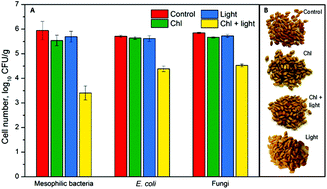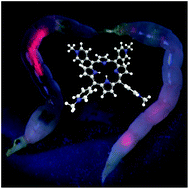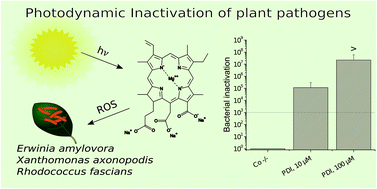Themed collection New and innovative applications of Photodynamic Inactivation of microorganisms

Conjugating biomaterials with photosensitizers: advances and perspectives for photodynamic antimicrobial chemotherapy
In this review we present the most recent examples of biomaterials, for the conjugation of photosensitizers for photodynamic antimicrobial chemotherapy.

Photochem. Photobiol. Sci., 2020,19, 445-461
https://doi.org/10.1039/C9PP00398C
Photodynamic action of Hypericum perforatum hydrophilic extract against Staphylococcus aureus
Hypericin (Hyp) is one of the most effective, naturally occurring photodynamic agents, which proved effective against a wide array of microorganisms.

Photochem. Photobiol. Sci., 2020,19, 324-331
https://doi.org/10.1039/C9PP00428A
Influence of stomach mucosa tissue on the efficacy of intragastric antibacterial PDT
To estimate the light action spectrum for the in vivo phototherapy of H. pylori in the visible range, we performed a simulation of the light transmitted by a simple optical model of the gastric wall structure.

Photochem. Photobiol. Sci., 2020,19, 34-39
https://doi.org/10.1039/C9PP00315K
Toward better microbial safety of wheat sprouts: chlorophyllin-based photosensitization of seeds
The chlorophyllin-based photosensitization treatment, being nonthermal, environmentally friendly and cost-effective, has huge potential for microbial control of highly contaminated germinated wheat sprouts and seeds used to produce sprouts.

Photochem. Photobiol. Sci., 2019,18, 2521-2530
https://doi.org/10.1039/C9PP00157C
Mosquito larvae control by photodynamic inactivation of their intestinal flora – a proof of principal study on Chaoborus sp.
The aim of this study is to investigate the potential of photodynamic agents to combat mosquito larvae, the carriers of dangerous pathogens around the world. All photosensitizers tested were observed in the digestive tract of the larvae.

Photochem. Photobiol. Sci., 2019,18, 2374-2380
https://doi.org/10.1039/C9PP00156E
Synthesis and photodynamic effects of new porphyrin/4-oxoquinoline derivatives in the inactivation of S. aureus
New porphyrin/4-oxoquinoline conjugates were synthesized and shown to be excellent photosensitizing agents in the inactivation of S. aureus by the antimicrobial photodynamic therapy protocol.

Photochem. Photobiol. Sci., 2019,18, 1910-1922
https://doi.org/10.1039/C9PP00102F
BODIPY-embedded electrospun materials in antimicrobial photodynamic inactivation
Electrospun BODIPY(+)-embedded nanofiber materials were capable of the detection-level photodynamic inactivation of drug-resistant Gram-positive and Gram-negative bacteria and viruses.

Photochem. Photobiol. Sci., 2019,18, 1923-1932
https://doi.org/10.1039/C9PP00103D
Save the crop: Photodynamic Inactivation of plant pathogens I: bacteria
Photodynamic Inactivation based on either sodium magnesium chlorophyllin combined with chelators or the novel chlorin e6 derivative B17-0024 is effective in photokilling Gram+ and Gram− bacterial phytopathogens.

Photochem. Photobiol. Sci., 2019,18, 1700-1708
https://doi.org/10.1039/C9PP00128J
A combination of photodynamic therapy and antimicrobial compounds to treat skin and mucosal infections: a systematic review
aPDT combined with antimicrobials could be promising to manage skin and mucosal infections.

Photochem. Photobiol. Sci., 2019,18, 1020-1029
https://doi.org/10.1039/C8PP00534F
About this collection
Microbial pathogens trouble mankind in practically all habitats around the globe. Motivated by the outstanding success of Photodynamic Inactivation in treatment of infections from head to feet, novel and very promising applications based on the light-induced and photosensitizer-mediated overproduction of reactive oxygen are constantly identified and explored by the research community, with great imagination and creativity.
This virtual themed issue provides two comprehensive reviews and a selection of articles on novel and promising developments in Photodynamic Inactivation ranging from biomaterial-conjugated photosensitizers to photoantimicrobial textiles. The collection will hopefully stimulate efforts to expand the convincing benefits of the antimicrobial photodynamic approach into new fields of application in human medicine and beyond.
Kristjan Plaetzer and Cristiano Viappiani (Guest Editors)